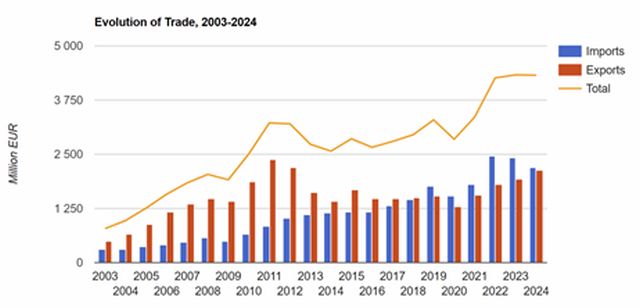- within International Law topic(s)
- with Finance and Tax Executives
- in United States
- with readers working within the Law Firm industries
In a time when geopolitical changes and disruptions in supply chains are transforming the landscape of international trade, forming strategic alliances has become crucial for sustained economic development. The Trade and Economic Partnership Agreement (TEPA) between India and the European Free Trade Association (EFTA) which includes Iceland, Liechtenstein, Norway, and Switzerland shines as a prime example of such collaboration. Set to take effect on October 1, 20251, this deal not only connects two vibrant economic regions but also aims to stimulate innovation, attract investments, and enhance cross-border trade. Officially signed on March 10, 20242, following nearly 16 years of discussions, the TEPA signifies a shared commitment to liberalising trade, boosting investment flows, and promoting sustainable growth. For business leaders looking to expand into emerging markets or diversify their supply chains, this agreement provides a roadmap for success, merging India's extensive consumer market and manufacturing capabilities with EFTA's technological know-how and premium exports.
As companies navigate through inflationary challenges, protective regulations, and the drive towards net-zero objectives, the TEPA surfaces as a timely enabler. It complements India's "Make in India" initiative and EFTA's emphasis on innovation-based economies, with the potential to unlock billions in trade value and generate over a million jobs in India within the next 15 years. This article examines the various business dimensions of the agreement, highlighting how it acts as a launching pad for corporate advancement, from tariff reductions to investment safeguards, while also addressing the legal structures that support its effectiveness.
Overview of the India-EFTA TEPA: A Strategic Alliance

The TEPA transcends a typical free trade agreement; it serves as a thorough economic partnership aimed at enhancing connections beyond simple tariff reductions. Encompassing trade in goods, services, investments, Intellectual Property Rights (IPR), government procurement, and sustainable development, the agreement consists of 14 chapters and seeks to eliminate or significantly lessen customs duties on 99.6% of India's exports to EFTA nations and 81% of EFTA's exports to India. This asymmetry mirrors India's developmental priorities, where it safeguards sensitive sectors such as agriculture and dairy while facilitating opportunities for industrial and service exports3.
From a legal standpoint, the TEPA includes strong dispute resolution mechanisms, which are inspired by World Trade Organisation (WTO) principles but customised for bilateral requirements. It features provisions for arbitration panels and Investor-State Dispute Settlement (ISDS), offering corporations protections against arbitrary regulatory alterations. For example, EFTA investors in India enjoy benefits from fair and equitable treatment clauses, non-discrimination standards, and safeguards against expropriation without compensation. These components are essential for multinational corporations (MNCs) navigating the intricate regulatory landscape of India, which encompasses the Companies Act, 2013, and the Foreign Exchange Management Act (FEMA).
EFTA's pledge to invest $100 billion in India over a span of 15 years highlights the ambitious nature of the agreement. This non-binding commitment, associated with job creation objectives, positions India as a focal point for European investments in sectors such as renewable energy, biotechnology, and advanced manufacturing. For EFTA countries, known for their high per capita incomes and innovation metrics, the agreement provides preferential access to India's rapidly expanding market of 1.4 billion consumers, which is anticipated to rank as the world's third-largest economy by 20304.
Key Clauses and Their Corporate Ramifications
At the heart of the TEPA are provisions that have a direct influence on corporate operations and profitability. Regarding the trade of goods, the agreement systematically eliminates tariffs on a broad spectrum of products. Indian exporters dealing in processed foods, textiles, electrical machinery, and pharmaceuticals will experience a reduction in duties to zero for most items entering EFTA markets. On the other hand, EFTA's renowned exports like Swiss watches, Norwegian seafood, and precision instruments will benefit from lowered barriers in India, enhancing competitive pricing and market access5.
In terms of services, the TEPA facilitates liberalisation in sectors essential for corporate advancement. Mode 4 commitments enable the smoother movement of professionals, which is advantageous for Indian IT companies and Business Process Outsourcing (BPO) firms aiming to grow in Europe. Service providers from EFTA, especially in financial services, research and development, and environmental consulting, will enjoy improved market access in India. This mutual benefit is legally secured through national treatment and most-favoured-nation (MFN) clauses, ensuring that foreign companies receive the same treatment as domestic firms.
Investment provisions represent a transformative element for business growth. The agreement encourages bilateral investments by streamlining approval processes and providing legal safeguards. Under Chapter 7, EFTA pledges to support investments in India's key sectors, including infrastructure and green technologies. This is in harmony with India's Production Linked Incentive (PLI) schemes, promoting joint ventures and technology transfers. Companies can capitalise on these opportunities to set up manufacturing operations in India, thereby lowering costs through local sourcing and exporting back to EFTA markets without tariffs.
Intellectual property rights constitute another fundamental component, with the TEPA standardising regulations to safeguard innovations. While India retains certain flexibilities under the TRIPS Agreement concerning public health, EFTA acquires greater enforcement capabilities regarding patents and trademarks. This is particularly advantageous for pharmaceutical leaders such as Novartis (Swiss) and Indian companies like Sun Pharma, facilitating collaborative R&D without concerns over intellectual property theft.
Sustainability clauses incorporate environmental, social, and governance (ESG) factors, requiring collaboration on climate change and labour standards. Businesses must adhere to these stipulations to access benefits, but they also create opportunities for green investments, such as Norway's expertise in offshore wind energy collaborating with Indian renewable energy firms.
Enabling Corporate Growth with Opportunities Across Sectors
The TEPA serves as a significant catalyst for corporate expansion by broadening supply chains and mitigating operational risks. In a post-COVID landscape, where dependence on singular markets has shown to be unstable, the agreement supports "China-plus-one" strategies. Indian enterprises can acquire advanced technological components from EFTA countries at reduced prices, thereby boosting their competitiveness within global value chains (GVCs).
For manufacturing industries, the agreement enhances the "Make in India" initiative. Diminished tariffs on machinery imports from EFTA will decrease capital expenses for Indian businesses, while export incentives promote increased production levels. For instance, engineering and automotive firms can partner with Swiss precision tool manufacturers, fostering innovation in electric vehicles (EVs) and smart manufacturing techniques.
In the fields of pharmaceuticals and biotechnology, the TEPA's intellectual property provisions and market access facilitate synergistic opportunities. Indian generic drug exporters can penetrate lucrative EFTA markets, potentially leading to revenue increases of 20-30% in specific segments. Concurrently, EFTA companies have the opportunity to invest in India's biotech centres such as Hyderabad, capitalising on cost efficiencies for R&D outsourcing.
The services sector, which is the backbone of India's economy, stands to benefit significantly. Exports of IT and business services to EFTA could experience substantial growth, with companies like Infosys and TCS establishing a presence in Europe. The agreement's digital trade section fosters e-commerce and data transfers, allowing businesses to effortlessly integrate AI and fintech solutions.
On a financial level, the $100 billion investment commitment results in concrete growth. Corporations can secure funding for infrastructure initiatives, such as high-speed rail projects or clean energy grids, through public-private partnerships (PPPs). This approach not only generates employment opportunities but also cultivates resilient ecosystems that attract further foreign direct investment (FDI).
From a risk management perspective, the TEPA's legal frameworks alleviate uncertainties. Arbitration clauses based on the UNCITRAL model ensure effective dispute resolution, thereby lowering litigation expenses for cross-border transactions. Tax considerations are also advantageous; while the agreement does not modify double taxation treaties, it promotes transparency in fiscal policies, supporting corporate strategic planning.
Strategic Considerations for Businesses
While the TEPA presents significant opportunities, companies must navigate challenges to fully leverage its advantages. Adhering to rules of origin (RoO) is essential. Products need to satisfy value-addition requirements (generally 35-60%) to be eligible for tariff reductions6. This necessitates supply chain audits and certifications, which could initially heighten administrative workloads.
Geopolitical elements, such as varying positions on sustainability standards, might create obstacles. EFTA's focus on carbon border adjustments could impact high-emission exports from India, prompting companies to quickly implement environmentally friendly practices.
Legal due diligence is crucial. Enterprises should examine India's FDI regulations, revised in 2020 to introduce automatic pathways for most industries, in conjunction with EFTA's efforts toward regulatory alignment. Engaging with local legal counsels for contract formulation and compliance will be vital in steering clear of potential issues.
Final word
The India-EFTA TEPA, which will take effect on October 1, 20257, is set to transform the business landscape between these regions, acting as a driving force for corporate growth in an interconnected global economy. By lowering obstacles, safeguarding investments, and fostering innovation, it empowers leaders to embark on ambitious expansion initiatives, ranging from market entry to collaborative ventures. As companies seize these prospects, the agreement not only enhances economic synergies but also supports global objectives such as sustainable development and inclusive growth. For visionary leaders, the TEPA represents more than just a trade agreement, it's a crucial strategy for succeeding in the economy of the 21st century.
Footnotes
1. Ibef. (2025, September 4). India, European Free Trade Association (EFTA) trade pact to come into force from October 1: Switzerland. India Brand Equity Foundation.
2. India. (2025, February 10). European Free Trade Association (EFTA).
3. Ibid.
4. EU sets out new strategy to reinforce prosperity and security with India. (n.d.).
5. The impact of India-EFTA trade and Economic Partnership a. . . (n.d.). Invest India.
6. Ibid
7. Pti. (2025a, September 3). India, EFTA trade pact to come into force from October 1: Switzerland. The Hindu.
The content of this article is intended to provide a general guide to the subject matter. Specialist advice should be sought about your specific circumstances.


